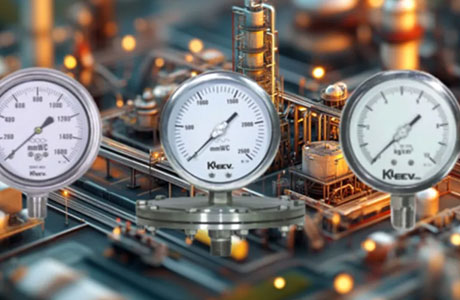What Is The Formula For Gauge Pressure?
Key Takeaway
The formula for gauge pressure is:
Gauge Pressure = Absolute Pressure – Atmospheric Pressure
Gauge pressure measures the pressure relative to atmospheric pressure. It is commonly used in practical applications since it excludes atmospheric pressure from the measurement. For example, tire pressure readings are typically gauge pressures.
Understanding Gauge Pressure and Absolute Pressure
Understanding gauge pressure and absolute pressure is fundamental to pressure measurement and its applications. Gauge pressure measures the pressure relative to atmospheric pressure, while absolute pressure includes atmospheric pressure in its measurement. These two types of pressure are essential in various industries, as they provide insights into fluid dynamics and system performance.
By comprehending these concepts, professionals can select the appropriate pressure measurement method for their specific needs, ensuring accurate data collection and analysis. This understanding is vital for maintaining system integrity, optimizing performance, and guaranteeing safety in operations. As technology evolves, staying informed about these concepts will enhance the ability to adapt to new measurement challenges and innovations.

Mathematical Formula for Gauge Pressure
The formula for gauge pressure is relatively straightforward. It is calculated as the difference between the pressure in the system and the atmospheric pressure. The formula is expressed as:
Gauge Pressure (P_g) = P_system – P_atm
Where:
P_system is the pressure inside the system (like a tire, tank, or pipe).
P_atm is the atmospheric pressure, which is typically considered as 101.3 kPa (or 1 atm) at sea level.
This formula allows us to understand how much pressure a system is exerting over and above the surrounding atmospheric pressure. Gauge pressure readings are used extensively in industries where the excess pressure in a system is more relevant than the absolute pressure. For instance, when monitoring a pressurized tank, the gauge pressure will tell us how much more pressure is inside the tank compared to the atmospheric conditions outside.
Practical Scenarios of Gauge Pressure Measurement
Gauge pressure measurements are essential in many real-world applications. For instance, in a car tire, the gauge pressure tells us how much air pressure is in the tire compared to the atmospheric pressure. This is important because tires need to be inflated to a certain gauge pressure to ensure safety, efficiency, and longevity.
Another example is in HVAC (Heating, Ventilation, and Air Conditioning) systems. These systems require the measurement of air pressure at various points to ensure proper functioning. A gauge pressure measurement will indicate if the system is running within the required pressure range. Similarly, in water systems, pumps and valves are often regulated using gauge pressure to maintain desired operational conditions.
These practical applications illustrate the importance of knowing how much pressure is present within a system relative to the environment, ensuring optimal performance and safety in various industries.
Differences Between Gauge Pressure and Other Pressure Types
The main difference between gauge pressure and other pressure types, such as absolute pressure and differential pressure, lies in the reference point. Gauge pressure measures the pressure relative to atmospheric pressure, which can be zero or negative, depending on whether the system is under or over pressure compared to the atmosphere. This is why gauge pressure can sometimes have a reading of zero or even a negative value if the internal pressure is lower than atmospheric pressure (such as in a vacuum).
Absolute Pressure is the total pressure, including atmospheric pressure. For instance, when measuring the pressure inside a vacuum chamber, the gauge pressure might be zero, but the absolute pressure is not, as atmospheric pressure is still present outside the system.
Differential Pressure measures the difference in pressure between two points within the same system. It is commonly used in flow measurement and filtration processes where pressure needs to be measured across components like filters.
Understanding these different types of pressure is critical in industries where precise pressure control is required, such as oil and gas, pharmaceuticals, and manufacturing.
Applications of Gauge Pressure in Daily Life
Gauge pressure plays a vital role in several applications encountered daily. From the tires of a car to the pressure in water systems, understanding gauge pressure ensures safety and performance.
In the home, a simple example is using a barometer to measure weather pressure, which is actually a form of gauge pressure, indicating how much pressure is exerted by the air compared to the normal atmospheric pressure. In industrial settings, pressure gauges are used in everything from boilers to pumps to track the pressure inside systems and avoid dangerous overpressures.
In healthcare, gauge pressure is used in devices like blood pressure monitors, where the measurement is taken relative to the atmospheric pressure. These devices use the principle of gauge pressure to measure the force exerted by the blood on the walls of the arteries, helping healthcare professionals diagnose various conditions.
Conclusion
In conclusion, the formula for gauge pressure is a critical aspect of understanding pressure measurement in various scientific and industrial applications. Gauge pressure is the difference between the absolute pressure and the atmospheric pressure, typically represented as P_g = P_abs – P_atm.
It is crucial for accurately measuring pressure in systems where atmospheric pressure variations can impact the readings. Understanding this formula allows for better calibration and maintenance of pressure-measuring devices, ensuring accurate results in research, manufacturing, and daily applications. Thus, a firm grasp of gauge pressure calculations aids in the development and improvement of pressure-sensitive technologies.

